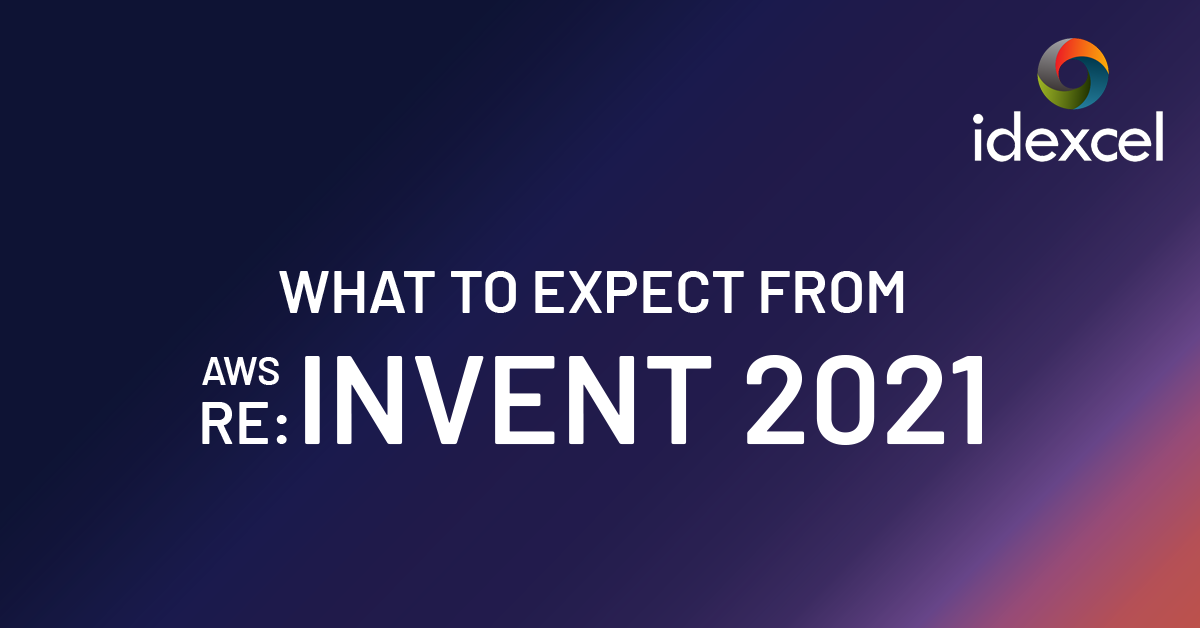AWS re:Invent 2021 is an Amazon Web Services annual technology conference scheduled for November 29 through December 3 in Las Vegas, Nevada. This is the largest annual Amazon Web Services (AWS) conference for partners and customers. The event is scheduled to include 1,500 technical sessions, a partner expo, training and certification opportunities, and multiple keynote announcements. Also, AWS re:Invent 2021 is dedicated to cloud strategies, IT architecture and infrastructure, operations, security, and developer productivity with a focus on AWS products and features. Irrespective of whether you are an engineer, a business leader, or just embarking on the cloud journey, this is an opportunity to discover everything the event has to offer. As an AWS Advanced Consulting Partner and Managed Service Provider (MSP), Idexcel is much excited and looking forward to this event.
Key Note Sessions
Keynote Session 1: Global Partner Summit – November, 29 (3:00 PM – 5:00 PM PST)
Doug Yeum – Head of AWS Partner Organization: Yeum is currently AWS’ head of worldwide channels and alliances. His responsibilities included engaging with c-level executives about their digital transformation and innovation strategies, developing business through channels & alliances, and managing business operations.
Sandy Carter – Vice President for Worldwide Public Sector Partners and Programs at AWS: She is responsible for driving next-generation partnering and evolving partner models to intensify partner innovation and AWS Cloud adoption.
Stephen Orban – General Manager of AWS Marketplace and Control Services: Orban formerly served for three years as general manager of AWS Data Exchange, a service launched in 2019 that makes it easy for AWS customers to find, subscribe to, and use third-party data in the cloud through Marketplace.
Keynote Session 2: AWS Customers, Products, & Services – November, 30 (8:30 AM – 10:30 AM PST)
Adam Selipsky – AWS CEO: Adam would take the stage to share his insights and latest news about AWS customers, products, and services.
Keynote Session 3: Databases, Analytics, & Machine Learning– December, 01 (8:30 AM – 10:30 AM PST)
Swami Sivasubramanian – Vice President at AWS: Heading up all Amazon AI and Machine Learning services and leading on all aspects of Machine Learning, from ML frameworks and infrastructure to Amazon SageMaker and AI services.
Keynote Session 4: AWS & Cloud Infrastructure – December, 01 (3:00 PM – 4:30 PM PST)
Peter DeSantis – Senior Vice President of AWS Global Infrastructure and Customer Support: Leading the AWS teams responsible for designing the data centers, servers, and network that underpin AWS services and for deploying and operating this infrastructure worldwide.
Keynote Session 5: Future of Software Development – December, 02 (8:30 AM – 10:30 AM PST)
Dr. Werner Vogels – Chief Technology Officer at Amazon.com: Dr. Werner is responsible for driving the company’s customer-centric technology vision and is one of the forces behind Amazon’s approach to cloud computing.
Offerings of re:Invent 2021
Here is a lineup of some of the expanded offerings of the event that you may want to check out:
Presentations
- Keynotes from AWS on cutting edge-technology and industry trends
- Leadership Sessions on a range of hot topics
- Breakout Groups and Q&A Sessions
- Expert Learning Lounges
- Builders’ Fair with Presentations and Question & Answer Sessions
- AWS Product Announcements
AWS Training & Certification
- Exam Readiness Sessions
- Remote Certification Examinations
- Hands-on Labs & Bootcamps
Hands-on Learning & Fun
- AWS DeepRacer Competitions
- Jams, Game Days & Hackathon
- Virtual Play Events
Performances & Entertainment
- Cooking Demonstrations
- re:Play – a Live Concert by a National Act
Our AWS re:Invent 2021 Predictions for ML Services
- Release of new generation ec2 instance for faster Machine Learning Training and Inference, which will offer a better Price-Performance Ratio.
- Amazon Textract will soon penetrate the market by providing extraction solutions that are domain-specific, covering specific types of document extraction solutions. We may see examples of specific types of documents that will be extracted.
- As we are in the midst of guiding ourselves through the pandemic, we will be aware that 2020 was a big year for medical image processing, particularly for chest x-rays. In this regard, we are expecting Amazon to announce a service similar to “Lookout For Vision” which will be used for anomaly detection, specifically focused on radiology-based images.
- An enhancement to Amazon Health Lake is expected to augment patient tracking and management.
- With the recent acquisition of Wickr, improvements in Lex are likely to be out later this year or early next year.
- A range of Automation options within AWS Service is likely to be announced.
- Furthermore, we look forward to big announcements of several incremental improvements to Amazon Rekognition service offering and additional flexibility in Machine Learning Training Models for images and videos.
Schedule a meeting with our AWS Cloud Solution Experts and accelerate your cloud journey with Idexcel.







